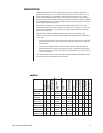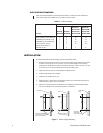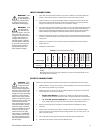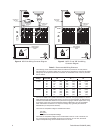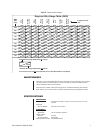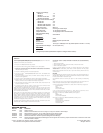
Pelco Manual C653M-D (9/03) 3
MODELS
Outputs
Supply Current
(Amps)
Max Current Per
Channel (Amps)
Input Voltage
(VAC)
Output Voltage
(VAC)
Required Input
Current (Amps)
Fuses
Circuit Breakers
Surge Protection
Class 2 Outputs
On/Off Switch
Power LED
Model Number
MCS4-2 4 2 1 120/240 24 0.44 X X X X
MCS4-2B 4 2 1 120/240 24 0.44 XXXXX
MCS8-5 8 5 3 120/240 24, 28 1.10/0.57 X X X X
MCS8-5B 8 5 3 120/240 24, 28 1.10/0.57 XXXXX
MCS16-10 16 10 3 120/240 24, 28 2.20/1.15 X X X X
MCS16-10B 16 10 3 120/240 24, 28 2.20/1.15 XXXXX
MCS16-10S 16 10 3 120/240 24, 28 2.20/1.15 X X 16 16
MCS16-10SB 16 10 3 120/240 24, 28 2.20/1.15 X X X 16 16
MCS16-20 16 20 3 120/240 24, 28 4.40/2.30 X X X X
MCS16-20B 16 20 3 120/240 24, 28 4.40/2.30 XXXXX
MCS16-20S 16 20 3 120/240 24, 28 4.40/2.30 X X 16 16
MCS16-20SB 16 20 3 120/240 24, 28 4.40/2.30 X X X 16 16
DESCRIPTION
The MCS Series consists of multi-output 24 VAC indoor power supplies. These power
supplies provide output for 4, 8, or 16 cameras from a single source and come in 2, 5, 10,
and 20 amp capacities. To compensate for voltage losses over long wire runs, 28 VAC
outputs are also available on most models. The power supplies allow for 120 or 240 VAC
line input. Higher capacity models can handle pan and tilt and receiver operation in addition
to the camera when they are used with integrated systems such as the Spectra
®
dome and
Esprit
®
Integrated Positioning System.
Each output on the MCS “S” and “SB” (switched) Series models features its own LED
power indicator and three-position switch (up = 24 VAC, center = off, down = 28 VAC). The
switch lets you individually turn each output off or quickly select between 24 and 28 VAC
without reconnecting wires.
All MCS Series models are available with either glass fuses or self-resetting circuit
breakers (poly switches). The following bullets explain the advantages and disadvantages
of each type:
• Glass fuses provide more protection than circuit breakers because they act faster and
are more precise. However, they are designed for one-time use and must be replaced
when they blow.
• Circuit breakers reset themselves when the fault is corrected, which eliminates the
need to replace fuses. However, they react more slowly, are affected by temperature,
and are not nearly as accurate—the amount of current required to trip one can vary as
much as 100 percent.
Since circuit breaker models do not require fuses and automatically reset themselves after
the fault is corrected, the breakers are not accessible.





